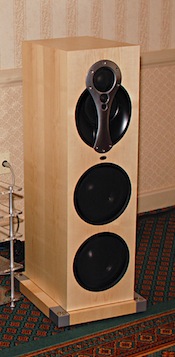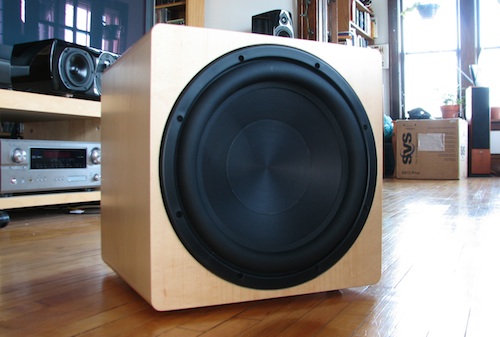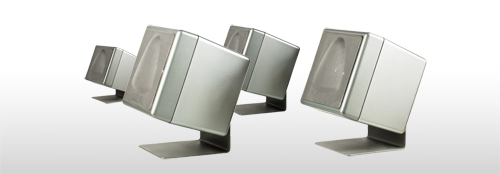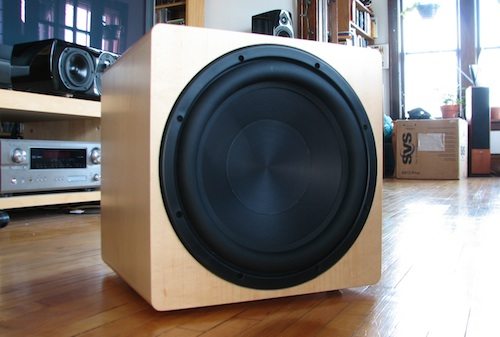 Missed part one? Catch up here.
Missed part one? Catch up here.Welcome to part two of my series helping you gain new enjoyment from ear training by showing you how to get the best sound quality. This week we are going to be talking about amps and speakers.
This is a huge subject and you could easily fill books on such esoteric subjects as crossover design and porting. I’m going to skip those topics and try to give you just the information you need to get great sound. In this article I’m assuming you are interested in stereo music content. Surround sound set-ups really deserve their own article and should be avoided unless you have a very large sum to spend, or you are only interested in home cinema.
Alive And Amplified
Amplifiers serve a simple purpose: they make things LOUDER!
An amplifier multiplies the incoming signal, giving it enough power to drive speakers or headphones. An amplifier can be separate, but may be combined in an all in one Boom Box, or Mini System, or in a pair of active speakers.
Modern amplifiers are great value for money and you don’t have to spend much on a separate hi-fi amp to have a wonderful quality of sound. I would avoid amplifiers that have lots of tone controls, graphic equalisers, or offer surround sound effects. Though a hi-fi laden with knobs and sliders has a certain 1980’s retro chic, tweaking them is unlikely to make music sound better and may interfere with frequency training.

This One Goes Up To Eleven
I very rarely turn the volume dial on my amplifier past a quarter, so I might reasonably ask myself: Do I really need that level of power, or have I wasted my money?
While its true you don’t need a huge amplifier unless you are planning a block party, running an amplifier at close to its maximum output level can introduce distortions to the signal. A good rule of thumb is to aim for an amplifier that can provide the level you need without having to turn it up past half way.
Speakers – Who Drives The Driver?
If there is one thing that I would recommend you splash out on it would be a great pair of stereo speakers.
A speaker is composed of two main parts. The driver converts electrical energy into movement in a cone which pushes the surrounding air to create sound waves. The drivers are mounted in an enclosure which is equally important in determining the sound quality.
Speakers are the part of an audio system which introduce the most distortion. If there is one thing that I would recommend you splash out on it would be a great pair of stereo speakers.
Woofers and Tweeters Aren’t Dogs and Birds
Drivers come in many shapes and sizes each with their own silly name:
- Tweeters are small drivers designed to reproduce high frequencies
- Mid Range speakers as you might expect are mid sized and create mid range frequencies (duh)
- Woofers are larger speakers designed to reproduce bass frequencies
- Subwoofers or Subs are designed to produce very low bass at the frequencies you feel as much as hear
In reality you don’t need to commit these names to memory unless you think it might be helpful in a pub quiz, but it is worth knowing that each type of driver is only good at producing sound within a fairly narrow range, so getting the best sound requires an enclosure with more than one driver. Budget speakers may just have a woofer and a tweeter and are called “Two Way”. Don’t get too hung up on the number of drivers when choosing speakers – a quality two way system is better than a dodgy four way.
Floor Standers and Book Shelves

A floor stander
(photo: jiannone@Flickr)
Floor standers are large enclosures designed to be used without stands. Some manufacturers pretend otherwise, but there is no substitute for size and weight with speakers. Floor standers offer the best sound quality for a given price and have excellent bass reproduction. Unfortunately they are also large and heavy and many people (myself included) simply don’t have space for them.
Bookshelf speakers are smaller speakers designed to be used on a stand of some kind. It is a rather unfortunate name, as a bookshelf is one of the very worst places to put a speaker – which is why some people call them “stand mount”.
If you have bookshelf speakers at home one of the easiest and cheapest things you can do to improve the sound of your set-up is to invest in decent stands. I recently moved some inexpensive book shelf speakers from a flimsy entertainment unit onto some budget £20 tubular steel stands and the improvement was marked.
Is It Time For A Cabinet Reshuffle?
If you aren’t happy with your set-up but you don’t have the money to spend on upgrading try moving your speakers around. Don’t squash speakers up against the wall, or in a corner and make sure they are a reasonable distance apart or you will loose the impression of stereo. Ideally you should be sitting at the point of a triangle with the drivers of your speakers facing you at around ear height. You may find tilting them in slightly can also help.
Don’t Be A Cable Mabel
… if you are planning on spending £1,000 on Hi-Fi equipment putting £200 aside for cables is frankly crazy
Once you’re chosen your speakers and your amp you’re going to need some cables to connect them together. Line level cables connect your source to your amp, and speaker cables connect the amp to the speakers. It’s not uncommon for hi-fi shops to tell you that you should reserve 10-20% of your hi-fi budget to spend on cables.
This is probably true for a budget system, but if you are planning on spending £1,000 on Hi-Fi equipment putting £200 aside for cables is frankly crazy. In most cases the basic stuff from your local hi-fi shop will do an excellent job. If a salesman tries to strong arm you into buying expensive cables remind them that the renowned Sceptic James Randi offered a million dollars to anyone who can tell the difference between overpriced cables and standard ones – and he still has his money.
Das Sub
If you are thinking of upgrading, you may be wondering if you should buy a set-up with a subwoofer or add one to your system. In general my answer would be no unless you already have a very high end system. The purpose of a subwoofers is to reinforce bass frequencies. Unlike other speakers you don’t need a pair because your ears aren’t very sensitive to the direction bass comes from. Cinemas use subs to provide the low frequency effect track (The ‘1’ in 5.1). These are the frequencies you feel through your seat as much as hear, for example thunder or an earthquake. Unless most of your listening is hip-hop or dub you don’t really need bass this low for music.

A standalone subwoofer speaker (photo: Roytex@Flickr)
If you do have a sub then turn the crossover (the frequency below which the sub takes over from the other speakers) down to the lowest frequency your main speakers manufacturer claims they can handle with a flat response. You will be surprised how little the sub needs to add for most music.
Satellite of Hate
Many systems, especially home cinema systems and PC speakers use satellite speakers. A satellite is a small speaker with only a tweeter to fill in directional detail while a central subwoofer provides the bass. Set-ups like this tend to have have lots of sizzling treble and boomy bass providing a very exciting sound for movies and games, but unfortunately tend to be next to useless for ear training, or enjoying well recorded music. Bose are a well known manufacturer of this type of system and in my opinion even in this luxury price range music performance is poor.

Satellite speakers - best avoided.
If your PC came with poor speakers and are looking for a good quality upgrade consider getting some powered monitors. These are speakers with a built in amplifier marketed at musicians for home studios. They are usually simple, well made, transparent sounding and free from gimmicks, which are all of my favourite things. M-Audio, Behringer and Edirol all make well priced examples.
Don’t Throw Out Your Boom Box!
It’s great to have a top of the range system but don’t forget most people don’t. If you are getting a system together to help you make recordings keep a boom box around to check it sounds OK on a basic system. Many top recording studios do this and musicians will often say they only realised they had a hit on their hands when they listened to their days work in the car on the way home!
Next time around the third article in the series will focus on how to find the right set of headphones.
Any questions? Leave a comment below, or come ask in the Forums!







